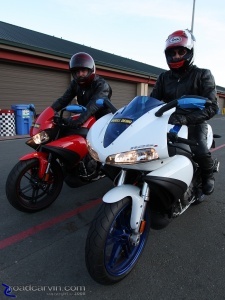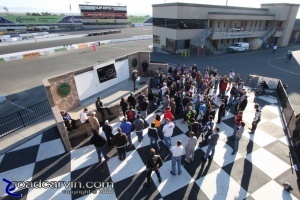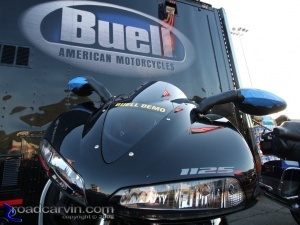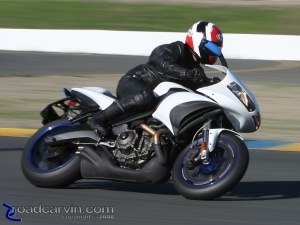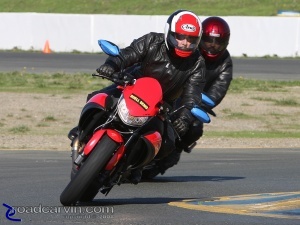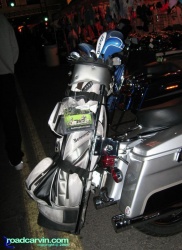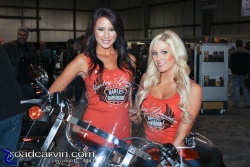Street riders hit the track with Buell's Inside Pass
Two street riders take a run at Buell’s Inside Pass Track Day
What's it like to ride your first motorcycle track day? What kind of challenges will you face as a new track rider?True confessions
I’m a longtime street rider, since the mid-‘70s when the café racer craze was taking hold in Northern California. I never got into that scene, though: hanging my butt off the bike seemed just too weird at the time. I was more of a pleasure rider but enjoyed pushing my luck by riding fast on my first street bike, a 1975 Honda CB400F.
I confess: I've done one motorcycle track day in my life, at Laguna Seca in the mid-‘90s. I rode my ‘93 Honda VFR750 shod with Metzeler street tires, and the bike handled as well as could be expected given its bulk and my abilities. I spent most of my time alternating between the sheer thrill of being on the track, and momentary fear as I tried to deal with the unfamiliar environment: safety crews, corner markers, braking points, and other riders. I recall nearly running off the track on the corkscrew exit, because I made the mistake of following another rider's line. Note to self: Choose your own line and stick with it, don't lock on to the rider in front of you.
Since that day, I’ve read both Twist of the Wrist: The Motorcycle Roadracers Handbook and A Twist of the Wrist 2: The Basics of High-Performance Motorcycle Riding
, as well as Ienatsch’s excellent Sport Riding Techniques
. I've tried to apply what I’ve learned from them: attention and traction budgets, turn-in points, cornering techniques, throttle and braking skills, and yes, a modest amount of ‘body English’—applying Ienatsch's guidance on pushing the outside knee up against the tank, sliding from one side to the other around the turns, just to see how it felt—and it felt good. Moving to the inside of the bike during cornering definitely raised my comfort level. Even so, I've not developed a persistent habit of hanging off the bike in turns.
No matter how much street riding I do or how confident I've become, there are things I won't do on the street. As a result, my ability to gain and improve critical sport riding skills is limited unless I can practice in a controlled environment, with input from other experienced riders. Yeah, I can do some of that on the street, but I'm far too aware of my own mortality to push the envelope much.
Over the years I've wanted to return to the track to improve my street skills and raise my confidence level. Work, family, budget, and web site development duties conspired to consume all available resources, so I've not returned. It's been so long since my first and only track day that I might as well be a complete beginner.
So, now you're in on my dirty little secret.
Buell’s Inside Pass Track Day
Buell sponsors these track days as a way to introduce street riders to track riding and provide a golden opportunity to try out the Buell motorcycle line-up at the track. Participants benefit from attractive entry fees, limited enrollment for increased track time, free food and drink and free take-home goodies: Event photos, Buell knee pucks and a tee-shirt. SportBike Track Time manages the track days for Buell.
We were invited to attend one of Buell's track days at Infineon Raceway on November 17, 2008. Dwight Domonkos and I attended this event; I'll share my experiences as a near-newbie and Dwight can add his thoughts.
Warming up: rider's meeting
The day started with an all-hands-on-deck meeting at the winner's circle, to review the general rules and track etiquette. What to do if you need to pull off the track, or if you crash. Flags and their meanings. Get off the track as soon as possible in case of a red flag—the ambulance can't roll until all riders are off the track! Things to do in order to ensure a successful day: keep the ego in check, there are no trophies. How to enter and exit the track. Where to find good passing opportunities. Oh, yeah: an accident or other incident in your class resulting in a delay will come out of your class's track time—the other groups won't pay for mistakes by your group—so play it safe in order to avoid losing track time. Pay attention to the instructor: if he (or she, of course) taps the tail of his bike, it means follow the instructor, he's going to show you a line through a turn. A raised hand followed by a tail tap means follow and exit the track.My head hurts already, and we aren't even on the track yet.
Rider classifications
Riders are organized into 3 classes, each having their own separate sessions in order to help prevent unnecessary carnage:
- Beginner/Novice: 3 or fewer track days.
- Intermediate: 3 to 10 track days, experienced "sport rider".
- Advanced: Considerable track day experience, very aggressive "sport rider".
I'm a novice, even though I have a lot of street experience. I'll just take it easy and see how I do, it's been a long time since my only track day.
Classroom instruction
We started each track session by attending a classroom meeting including a review of the previous session and discussing areas to focus on during the upcoming session:
Classroom session 1
- Respect the 6 foot 'bubble' exclusion zone around every rider.
- Use extreme caution entering the track from the pits. Stay to the left while heading up the hill from turn 1 to turn 2, in order to avoid crossing the path of much faster riders coming from the start/finish line.
- Heads up: look where you want to go.
- Reference points: watch for markers to use when riding the track
- Countersteering: practice makes perfect.
- Passing restrictions: When passing is allowed in afternoon sessions, only on straightaways.
- Let your instructor know if you are riding too fast or too slow for the group so they can put you in a group with similar skills.
Classroom session 2
Same as session 1, and:
- Keep your toes from dangling: balls of feet on pegs. I've already had that point driven home by reading Twist of the Wrist and other materials.
- Blip throttle on downshifts to match engine RPM to transmssion. Been doing that since I was a wee lad.
- Clutchless upshifts. The transmission won't hate you if you do it right. Hey! This is beginning to sound a lot like one of my Sunday rides!
- Braking: Smooth, progressive, keep a light touch. Any modern sportbike will come to a rapid halt with two fingers' pressure.
- Don't load the suspension by going into the turn hard on the brakes.
- Turn entry/exit: Delay entry for a tight exit. Early entry leads to a wide exit. Beware!
- If the throttle got you into trouble, it's more likely to get you out—Don't chop the throttle!.
- Hot Pit if you run in to traffic. Don't let slower traffic frustrate you if you can't pass, back off and let them get ahead of you by taking a leisurely trip through the pits.
Classroom session 3
Same as sessions 1 and 2, adding:
- Body position: Keep the hands and arms loose, keep the chest down towards the tank. Float like a butterfly...
- Try shifting the body centerline towards the inside of the turns.
- Remember the clutchless upshift...
Infineon track map
Here's the track map showing the course set-up during our track day. This is the 'AMA Superbike' layout, which emphasizes cornering over speed. The Carousel is at turn 6 and the Chicane is at turn 9a. Track entry from the pits is at turn 1 and the exit at turn 11.

Morning sessions: track instruction
We rode in the beginner's class, 3rd group. Before heading out to the first track session, our instructor asked us if we had any specific goals for the day. I told him my main goals were survival and avoiding total humiliation...During our morning sessions, our instructor did a fine job of monitoring the group, spending about 1/4 of his time looking back to see how we were doing, and adjusting his pace to the group's abilities. Though each group departure was spaced to ensure an uncrowded track, we soon caught up with the first two groups during each session—partially due to our instructor increasing the pace to match our abilities, and partially due to minor problems ahead that slowed the first two groups.
I noticed some of the riders ahead of me having occasional trouble holding a stable line through turns. My thoughts at the time: How am I doing? Am I causing problems for the rider behind me? Am I improving? Getting worse? Hard to tell... but it feels right.
After each session, the instructor gave us feedback and answered questions. His initial advice to me was to just relax and enjoy the day, and not to worry about too much at once—focus on improving one aspect of my riding technique. Now that's advice I could use. Sensory overload is a definite issue for me on my first day at the track.
Lunchtime: mmm... food...
The free catered lunch was better than I expected (I don't expect much at these kinds of events!) Tasty grilled lemon chicken over rice, salad and herbed potatoes. Lunch at a racetrack... simple and satisfying. Black leather garb and mid-70's temperatures made it a bit less comfortable than I'd have preferred, but it was a small price paid gladly (the weather was phenomenal.)
Our crew sat at an outdoor table and reviewed what we'd learned on and off the track up to that point. Dwight and I talked about hang-ups, places on the track where we had problems. I confessed to being slightly nervous about the Carousel (turn 6); Dwight said he had trouble in turn 9a.
Afternoon sessions: "free" time
After lunch, we attended one last classroom session, where we were reminded that much of the blood that kept our brains functioning is speeding to our guts to help digest that tasty meal, so we'll be at a disadvantage this afternoon—reminding us to pay attention, take it easy, play it safe. Given the fine warm weather we had to be careful about dehydration—so we were reminded to drink up between sessions. With these reminders planted firmly in my blood-starved brain, I headed out for the next track session.The afternoon sessions are more free-form than the morning: we're monitored but free to set our own pace. Passing is allowed on straight sections, if you can do it while respecting the 6 foot bubble. Instructors are out on the track but are otherwise unobtrusive. We're 'on our own' in a sense: we have to set our own pace and pick our own lines. We're encouraged to work on the things we learned in the track sessions earlier in the day.
I watched other riders blow a few turns, so I remind myself to stay focused and avoid brain fade. There was one minor incident during an afternoon novice session; a rider ran off the track at low speed in turn 9a. He was unhurt, but the aftermath ended the session early (ambulance and emergency workers rushed to the scene once all riders were off the track.) We lost our next session due to the time delay.
Later in the afternoon, I began to relax a bit and try to increase my pace, improve my lines and work on other elements of my riding style. It gets a little easier once you become more familiar with the track and are not quite so overwhelmed by the 'newness' of everything. Sensory overload fades away and you can start to focus on the important bits. I know that I didn't make major improvements but I felt more at ease and was able to step up the pace a bit. Dwight and I pulled off the track (by going through the hot pit area) a few times to avoid dealing with a gaggle of slower riders, which gave us more time to focus on our riding rather than trying to pass several riders in the limited space available.
Infineon Raceway "keeps you busy"
I overheard our instructor comment that Infineon is a great ride if you get into the rhythm of the track, and that it's a "busy" track—that characterization was confirmed during my sessions, as I was almost always busy setting up for the next turn. The track configuration that day ensured a tight and twisty ride, which I found surprisingly enjoyable. I really liked the Chicane at turn 9a, looking forward to each opportunity to practice setting up for the turn. (I've always enjoyed low-speed tight turns and switchbacks.)
Just when you thought you were fast... you were only half-fast.
I thought I was doing pretty well, hauling the Buell 1125CR through the chicane and accelerating out of the turns. Then I looked at photos taken by our photographer, comparing my passes through the chicane (turn 9a) with those of more advanced riders... sheesh, what a let-down. It showed me that when I think I'm working the bike well and hauling the bike over on its side, I'm probably not. Here's an example comparing my typical performance through turn 9a with that of a more experienced rider:
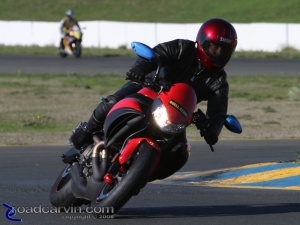
Author slogs through turn 9a: Yeah, things are going pretty well. Or so I thought. I'm looking to the turn exit at this point.
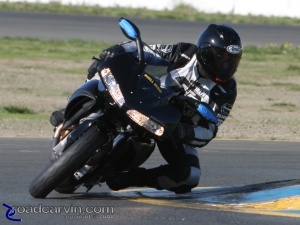
Ken Hill - turn 9a: Racer Ken Hill rides confidently through the turn. Notice how far ahead he's looking... towards the next turn entry point, it seems.
I realize that I'm not at the same point in the turn as Ken Hill in these photos, but I can assure you that when I was deep in the turn I wasn't looking as far ahead as Ken. Yup. I recall what I was doing. I was looking about 20 feet ahead of the bike through the turn. (Picture me hanging my head in shame.) Seeing the photos above and to the left, reflecting on my performance through the Chicane (and the Carousel and other turns), I realize that one of the reasons I'm not going as fast as I could be is that I'm focusing in too close—I'm not looking towards the next turn as early as possible. I haven't yet grown comfortable with the track, I don't yet trust my line choices... and I'm looking midway through the turn at least until I pass the apex well into the turn exit. (I don't recall having this problem on street rides where I know the road well and I'm comfortable with the lines I've chosen.) I think this is something I can improve on my next track day.
So, you see... there's always room for improvement. Don't get cocky, kid! Or something like that.
Let's do it again...
...I think I've created a monster. Or at least fueled a minor addiction.
This track day has intensified my desire to return to the track on a regular basis... I’m planning at least twice a year—and I'm hoping to do it more often than that. I expect to gain increased confidence and ability as a result of additional time at the track.
Credits
Buell Inside Pass - The Ultimate Track Day By Buell Motorcycles.
Track photography by Keith Breazeal of Keith Breazeal Video Productions.
Track map courtesy of Infineon Raceway.
Note
Roadcarvin magazine attended the Buell Inside Pass Track Day at Infineon November 17, 2008 as guests of Buell Motorcycles, and we were given an opportunity to ride the 2009 Buell 1125R and the new 2009 1125CR. This article focuses on the track day sessions. Click here if you want to know what we thought of the 2009 Buell 1125R and 1125CR.
Current Poll
Recent Comments
About the author
Author Name
Michael Curry
Author Bio
Michael has been riding street motorcycles since 1975. He's owned and ridden everything from Hondas to Harleys with a preference for spirited sport-touring riding.
Michael is a Roadcarvin.com co-founder and serves as chief editor, scribe, staff photographer, and other things.

